Criminal court statistics quarterly: April to June 2022
Published 29 September 2022
Applies to England and Wales
We are trialling the publication of this statistical bulletin in HTML form at alongside the usual PDF version and we are seeking user feedback on the use of HTML for the publication of statistical bulletins. Please send any comments to: [email protected].
Main Points
| Magistrates’ court: outstanding case volumes decreased | Case receipts and disposals decreased, remaining below pre-COVID levels. Disposal volumes remain above receipts, so outstanding cases fell 2% on the previous quarter and 8% on the previous year. |
| Crown Court: outstanding case volumes increased | Receipts (2%) and disposals (9%) fell on the previous quarter, with disposals falling below receipts. As a result, the outstanding caseload increased for the first time since its peak in Q2 2021, an increase of 2% from 58,398 at the end of March 2022 to 59,687 at end of June 2022. |
| Crown Court: slight rise in outstanding cases open for a year or more | More than a quarter (28%) of outstanding cases have been open for a year or more, up from 27% in Q1 2022 and 19% in Q2 2021. |
| Crown Court: ineffective trial rate increased | The ineffective trial rate at the Crown Court increased form 27% in the previous quarter to 31% in Q2 2022 - well above levels seen between 2014 and 2019 (13%-19%). A lack of defence advocate availability has become the primary reason for ineffective trials in the latest quarter, likely influenced by Criminal Bar Association action. |
| Timeliness fell at the magistrates’ court | The time from offence to completion at the magistrates’ court fell by 4%, to 189 median days, but remains above pre-COVID levels (175 median days in Q1 2020). |
| Timeliness fell at the Crown Court (end-to-end) | The time from offence to completion at the Crown Court fell by 8% in the previous quarter, with median estimates down to 378 days in Q2 2022 – this remains well above pre-COVID levels (252 days in Q1 2020). |
The technical guide to ‘Criminal court statistics’ and ‘Language interpreter and translation services in courts and tribunals’ can be found at the links below:
https://www.gov.uk/government/publications/a-guide-to-criminal-court-statistics
Statistician’s comment
This report covers the period to the end of June 2022.
The latest figures show Crown Court outstanding caseloads increasing for the first time in over a year as a result of disposals falling below receipts. This is likely, at least in part, due to the Criminal Bar Association action. Outstanding caseloads at the magistrates’ court continued to decrease, where both disposals and receipts fell in the latest quarter.
The proportion of trials which are rescheduled on the day of trial (‘ineffective’) at the Crown Court has also increased in the latest quarter, with (lack of) defence barrister availability becoming the strongest contributing factor.
Timeliness estimates, which reflect the length of time a case has taken at the point of completion and therefore covers the period where the pandemic disrupted court processes, showed a mixed picture. Timeliness decreased in both Magistrates and Crown Court but remain above pre-COVID levels.
1. Changes to note
Common Platform and reform to criminal court data[footnote 1]
‘Common Platform’ is a new digital case management system for the magistrates’ and Crown Courts. The system seeks to streamline data collection, data accessibility and improve the way criminal cases are processed across the Criminal Justice System. It will eventually replace the existing ‘legacy’ criminal court systems Libra (magistrates’) and XHIBIT (Crown), with a single, streamlined system.
Early adopter courts across England and Wales are testing the system before the subsequent rollout to all criminal courts concludes. Derbyshire magistrates’ and Crown Court began this process in September 2020 and the roll out has continued across England and Wales[footnote 2].
New cases entering courts from the point at which they adopt the Common Platform are held on the new system – cases that began at court prior to that court transitioning to Common Platform will remain on the ‘legacy’ system (e.g., LIBRA or XHIBIT).
All measures relating to magistrates’ courts and Crown Court cases include both ‘legacy’ and Common Platform estimates on a ‘best equivalent’ basis. This includes all key breakdowns in published quarterly tables and associated data tools.
Methodologies are as similar as possible however there are areas of known difference. The ‘legacy’ and ‘new’ data systems are fundamentally different, they do not record information in the same way and as such it is not possible to exactly replicate the existing published methodologies.
Areas of known difference that impact the statistics in this release include: the allocation of case type (such as triable-either-way, indictable only, committed for sentence and appeal), the inability to account for case transfers, main hearing allocation and changes to case ownership.
We will continue to develop data processes from the new system in collaboration with HMCTS and partner agencies as the Common Platform roll out continues. As we continue to develop these solutions, some series may be disrupted, with an increased likelihood of revisions to data in future.
We are committed to ensuring that published statistics remain accurate, robust and coherent for users during the operational transition of data systems at the criminal courts. For further information regarding the extent of the differences summarised above please see the Guide to criminal court statistics.
Failure to Appear Warrants
We previously included experimental statistics based on HMCTS data on failure to appear warrants issued in this publication. With the changes to court case management systems, it is not currently possible to produce this data robustly and these have been discontinued. HMCTS will continue to review the possibility of reinstating this data in the future against user needs and competing priorities.
2. Criminal cases in the magistrates’ courts
Disposals at the magistrates’ courts decreased, but remain above receipts, leading to a reduction in outstanding cases which remain above pre-COVID levels.
Receipts and disposals decreased by 5% and 6% respectively. Disposals were above receipts, and as a result outstanding cases decreased by 2% on the previous quarter.
Figure 1: Magistrates’ courts caseload, Q2 2012 – Q2 2022 (Source: Table M1)

Magistrates’ court caseload
Receipts and disposals have tended to rise from series lows in Q2 2020 when measures were put in place to manage the risks of the pandemic in courts[footnote 3]. However, levels remain below those seen prior to the pandemic following the review of court arrangements on the 23rd March 2020[footnote 4] and the return of restrictions in January 2021[footnote 5].
-
Receipts into the magistrates’ courts decreased by 5% on the previous quarter but were 5% higher than the previous year. Volumes remain lower than levels seen pre-COVID.
-
Disposals at the magistrates’ court decreased by 6% on the previous quarter and 3% on the previous year. The latest quarterly fall is most acutely seen in an 8% decrease in ‘summary motoring’ disposals in the latest quarter. Overall, disposals remain below levels seen.
-
At the end of June 2022 there were 333,887 outstanding cases at the magistrates’ court. This represents a 2% decrease on the previous quarter (342,056) and a 21% decrease on the series peak seen in Q2 2020 (422,169).
The latest published HMCTS management information provides monthly volumes of receipts, disposals and outstanding cases for all cases types at the magistrates’ courts (e.g. including civil and enforcement in addition to criminal cases).
Data to July 2022 shows that disposals have fallen below receipts and as a result, the open caseload has increased by 1.5% from the previous month.
Trial efficiency
There were 21,690 trials listed for Q2 2022, this is a decrease of 7% on the previous quarter (23,398).
- Of trials listed for Q2 2022, the proportion that were ineffective (21%) remained above pre-COVID levels. The effective (40%) rate remained unchanged and cracked trial rate (38%) increased slightly from 37%.
Figure 2: Magistrates’ courts listed trials and ineffective trial rate, Q1 2014 – Q2 2022 (Source: Table M2)

Vacated trials are trials which have been removed from the listing before the date of the trial, they are counted in the period the vacation happened rather than the date when they were due to be listed (as for effective, cracked and ineffective estimates).
- There were 5,203 trial vacations in Q2 2022, this represented a decrease of 2% on the previous quarter and remains at levels seen pre-COVID.
3. Criminal cases in the Crown Court
The volume of outstanding cases at the Crown Court has increased.
Having returned close to pre-COVID levels in the previous quarter, case receipts and disposals have fallen. In Q2 2022 disposals fell below receipts for the first time since Q2 2021. As a result, the volume of outstanding cases increased by 2% on the previous quarter, to 59,687.
Crown court caseload
The increased throughput from the magistrates’ courts as part of the ongoing recovery from the pandemic response saw the volume of receipts at the Crown Court exceed pre-COVID levels in late 2020. Subsequently receipts have fallen and remain slightly below pre-COVID levels.
Figure 3: Crown Court caseload, Q1 2014 – Q2 2022 (Source: Table C1)
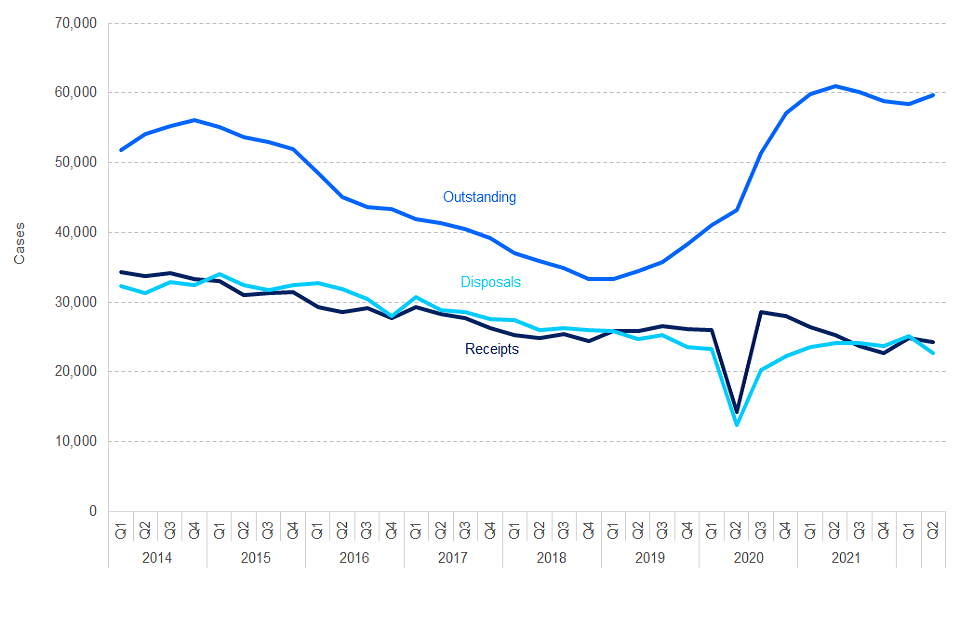
The phased reintroduction of jury trials[footnote 6] resulted in a gradual rise in disposals at the Crown Court up to Q1 2022. In the latest quarter Criminal Bar Association actions has contributed to disposals falling below receipts, and resulting in them being slightly below levels seen pre-COVID.
-
There were 24,295 case receipts into the Crown Court in Q2 2022. This is a fall of 2% on the previous quarter.
-
There were 22,753 case disposals at the Crown Court in Q2 2022. This has fallen by 9% on the previous quarter and below levels seen pre-COVID.
The outstanding caseload at the Crown Court increased for the first time since Q2 2021, halting the gradual falls seen between Q3 2021 and Q1 2022. At the end of Q2 2022 there were an estimated 59,687 outstanding cases at the Crown Court, up 2% on the previous quarter (58,398).
The latest published HMCTS management information provides monthly volumes of receipts, disposals and outstanding cases for all cases types at the Crown Court.
The data to July 2022 shows disposals remain below receipts. This has caused the open caseload to increase by 1.5% compared to June 2022.
Analysis of the outstanding caseload at the Crown Court - experimental statistics
To address additional interest in the outstanding case estimates at the Crown Court we are continuing to publish ‘experimental statistics’ providing estimates of the average length of time (days) that a case has been outstanding.
Figure 4: Age of outstanding cases at the Crown Court, Q1 2014 - Q2 2022 (Source: Table O1)

The age of an outstanding case is calculated from the point of receipt into the Crown Court and the latest outstanding date, e.g., as at the end of June 2022.
The average age of an outstanding case has increased sharply during the COVID-19 pandemic period, with recent falls continuing in the latest reporting period for the median average.
- In Q2 2022 the median age of all outstanding cases fell by 5% on the previous quarter, from 178 days to 169 days. The quarterly decrease in median age is true across all case types to varying degrees, excluding appeals and sentence cases.
Figure 5: Proportion of outstanding cases at the Crown Court by grouped age, Q1 2014 - Q2 2022 (Source: Table O3)
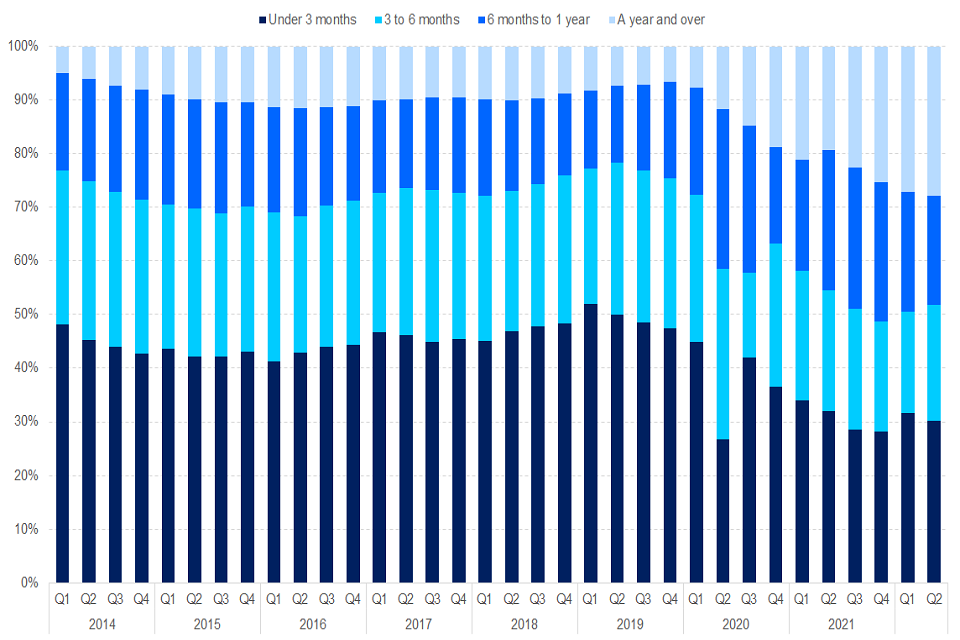
At the end of Q2 2022 there were 16,315 cases that had been outstanding for a year or more, with 3,900 of these cases outstanding for over two years. This has increased sharply following the pandemic response and represents 28% of all outstanding cases in the latest quarter, up from 27% in the previous quarter and at the highest level seen across the series.
Trial efficiency
The volume of trials at the Crown Court was falling prior to the pandemic, trending down since 2015. There were 5,746 trials listed for Q2 2022, down 19% on the previous quarter and up 6% on the previous year – with volumes similar to those seen pre-COVID.
The ineffective trial rate has increased in the latest quarter to 31%, the highest since Q2 2020. A lack of defence advocate availability has become the primary reason for ineffective trials in Q2 2022 following the start of the Criminal Bar Association action, with ‘overlisting’ and defendant absence continuing to be strong contributing factors.
Figure 6: Crown Court listed trials and ineffective trial rate (%), Q1 2014 – Q2 2022 (Source: Table C2)

Vacated trials are trials which have been removed from the listing before the date of the trial. They are counted in the period the vacation happened rather than the date when they were due to be listed (e.g., as for effective, cracked and ineffective estimates).
- There were 4,272 vacated trials in Q2 2022, down by 11% on the previous quarter (4,814) and below the series peak of 5,077 seen in Q1 2021.
Guilty plea rates
In the early stages of the pandemic, the guilty plea rate[footnote 7] reflected the restricted ability of courts to progress jury trials (i.e., cases where a not guilty plea is entered) and resulting changes in case mix.
More recently (Q3 2021 onwards) the guilty plea rate among defendants dealt with in ‘for trial’ cases at the Crown Court fell back to pre-COVID levels, reaching 66 in Q2 2022 (in contrast to a series peak in Q2 2020 of 79%).
- Of defendants dealt with who entered a guilty plea, 36% entered a plea on the day of trial (‘cracked trial’) – this represents a reduction on the previous quarter, when figures reached a series peak of 41%, and is similar to pre-COVID levels (35% in Q1 2020). Correspondingly the proportion of guilty pleas entered prior to trial has increased from 55% in Q1 2022 to 58% in Q2 2022, but remains below pre-COVID levels (63% in Q1 2020).
The volume of defendants dealt with following the entry of a not guilty plea fell in Q2 2022 by 8% on the previous quarter but has increased 3% on the previous year.
Average waiting and hearing time at the Crown Court
The waiting time estimates are a ‘lagged measure’ and defendants are counted at the point of their case being disposed of. As such the waiting time estimates provide a ‘backwards’ look at the durations spent between receipt and main hearing at the Crown Court.
The median waiting time[footnote 8] for defendants dealt with at the Crown Court was 8.4 weeks in Q2 2022. This represents a 12% fall on the previous quarter (9.7 weeks) and no change on the previous year, although remains above pre-COVID levels (5.3 weeks in Q1 2020).
- The median waiting time for defendants dealt with in ‘for trial’ cases where a not guilty plea was entered increased by 4% (to 39 weeks) compared to the previous quarter and the previous year (37.6 weeks in Q1 2022 and Q2 2021).
Average hearing time at the Crown Court
The hearing time estimates are a ‘lagged measure’ and cases are counted at the point of disposal. As such the hearing time estimates provide a ‘backwards’ look at the duration of hearings at the Crown Court.
The median hearing time[footnote 9] of ‘for trial’ cases where a not guilty plea was entered was 12.3 hours. This is down by 1% on the previous quarter and down 3% compared to the previous year.
4. Timeliness
The time from offence to completion fell at the magistrates’ courts and at Crown Court (end-to-end).
The median time from offence to completion for cases completing at the magistrates’ court decreased by 4% on the previous quarter, from 198 days to 189 days in Q2 2022. At the Crown Court, end-to-end timeliness from offence to completion fell by 8%, from 409 to 378 in Q2 2022.
The timeliness measures are based on defendants whose cases have been completed, as such they are ‘backwards’ looking measures of timeliness between offence and completion at the relevant criminal court jurisdiction.
Experimental statistics using a new data linking methodology have been developed using the Ministry of Justices open-source statistical ‘Splink’ package to provide updated end-to-end timeliness estimates.
Alongside the gradual development of the experimental statistics we will continue to try to best meet user demands via more granular data on separate (‘unlinked’) timeliness estimates for magistrates’ courts and Crown Court.
-
Magistrates’ court timeliness estimates (T1 – T3) – providing estimates of the time from offence to completion for defendants dealt with at the magistrates’ courts.
-
End-to-end timeliness estimates (T4) – providing estimates of the time from offence to completion for defendants dealt with at Crown Court.
-
Crown Court timeliness estimates (E1 – E2) – providing estimates of the time from case receipt at the Crown Court to completion.
Magistrates’ court timeliness
Timeliness at the magistrates’ courts measures the time from an offence being committed through key stages of the criminal justice system including charge, first listing at the magistrates’ court and subsequent completion at court.
Figure 7: Average number of days from offence to completion for cases completing at the magistrates’ courts only by stage, Q2 2010 – Q2 2022 (Source: Table T3)

The median duration from offence to completion of defendants dealt with at the magistrates’ courts decreased by 4% from 198 days in Q1 2022 to 189 days in Q2 2022.
-
‘Pre-court’ time fell, with the median time from ‘offence to charge’ down 3% on the previous quarter but 3% higher than in Q1 2022. The median time from ‘charge to first listing’ remained stable at 35 days.
-
‘At court’ median estimates remained stable at 0 days, where the first listing and completion occur on the same day. However, the mean duration continued to fall, down from 33 days to 29 days – this follows sharp increases seen over the COVID period and the latest estimate remains well above levels seen pre-COVID (e.g., 19 days in Q1 2020).
Crown Court timeliness - experimental statistics
‘Unlinked’ timeliness estimates at the Crown Court are measured from the point of a case entering a Crown Court, reaching a main hearing and then completing at court. This data series remains in development and is considered ‘experimental statistics’. Data presented here is not produced on the same basis as linked end-to-end timeliness data.
The median duration from case receipt to completion at the Crown Court for all cases was 142 days, a reduction on the previous quarter (162 days).
Figure 8: Median duration from receipt to completion in ‘for trial’ cases by plea at the Crown Court by case type, Q1 2014 - Q2 2022 (Source: Table E2)
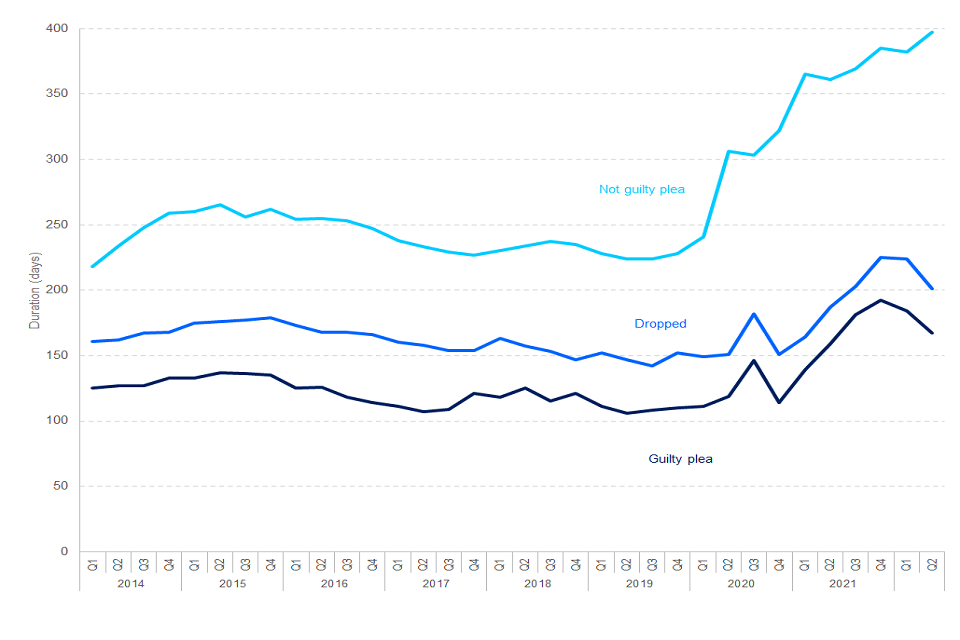
In ‘for trial’ cases where a not guilty plea was entered, the median duration from receipt to completion at the Crown Court increased by 4% on the previous quarter, reaching a new peak of 397 days in Q2 2022. Compared to Q1 2022 the time from ‘receipt to main hearing’ increased from 280 to 286 days, while the time from ‘main hearing to completion’ increased from 41 to 49 days.
End-to-end timeliness - experimental statistics
The median duration from offence to completion for defendants dealt with at the Crown Court fell by 8%, down from 409 days in Q1 2022 to 378 days in Q2 2022.
This continues small quarterly falls since the series peak of 436 days in Q3 2021 which followed sharp increases following the COVID-19 pandemic response. The latest median estimate has fallen below estimates in the previous year (392 days in Q2 2021) but remain well above pre-COVID levels (252 days in Q1 2020).
Figure 9: Average number of days from offence to completion for defendants dealt with at the Crown Court, Q1 2021 - Q2 2022 (Source: Table T4)
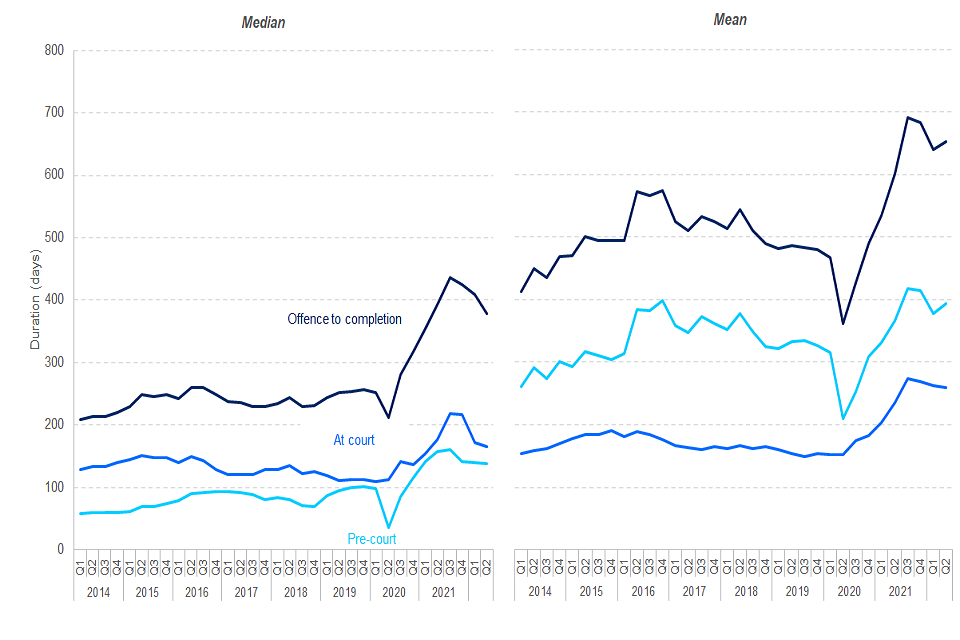
A continued decrease can be seen for the median estimate of time spent ‘at court’ (e.g., from first listing at the magistrates’ courts to completion at the Crown Court), falling 4% in the latest quarter from 171 days in Q1 2022 to 165 days in Q2 2022. The latest estimate remains well above those seen pre-COVID (109 days in Q1 2020).
5. Experimental Statistics – enforcement of financial impositions
Total financial impositions fell back from a series peak
Total financial impositions in Q2 2022 were £132.8 million, down 15% from £155.5 million in Q2 2021. The total value of outstanding financial impositions was £1.36 billion in Q2 2022, down by 4% on the previous quarter.
Financial impositions and amounts paid by imposition type
The overall value of impositions has recently stabilised close to pre-COVID levels but is subject to quarterly variation. In Q2 2022 the value of impositions was down by 15% compared with Q1 2022.
Outstanding financial impositions
In Q2 2022, the total value of financial impositions outstanding in England and Wales was £1.36 billion, down 4% on the previous quarter. However, this remains 10% up on the previous year (£1.24 billion).
The amount of outstanding financial impositions has more than doubled since the start of 2015 (£571m). A change in policy regarding the collection of financial impositions is partially behind this cumulative increase – unpaid accounts are no longer routinely closed and therefore, more outstanding impositions are carried over from previous periods.
6. Experimental Statistics – language interpreter and translation services
The number of completed language service requests decreased on the previous quarter and the success rate remained broadly stable.
There were 43,220 completed requests in Q2 2022, down 2% on the previous quarter. The success rate for requests was 97%, broadly stable with the rate seen since 2015.
Completed service requests
There were 43,220 completed requests in Q2 2022, down 2% on the previous quarter (44,107) and 8% above the volumes seen in the same quarter of the previous year (39,903). The volume of completed requests has returned to levels seen prior to the COVID-19 pandemic.
Figure 10: Number of completed language service requests and overall success rate, Q1 2013 – Q2 2022 (Source: Table L1)
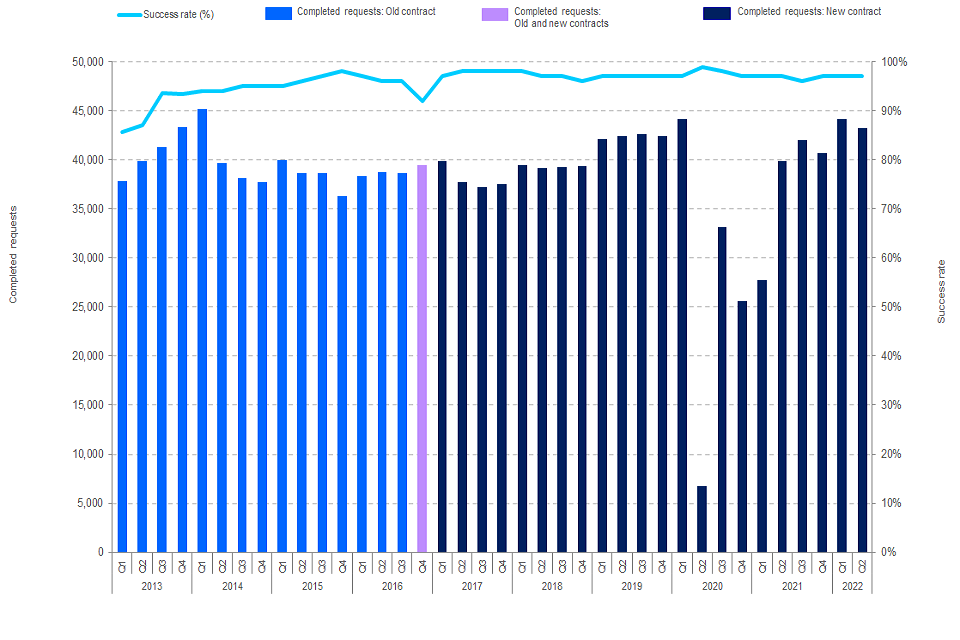
Success rate
The overall success rate of requests was 97% in Q2 2022, this is similar to rates seen since 2015. The proportion of cancellations (which are excluded from the success rate calculation) increased in Q2 2020 to 34% – this has fallen back to 23% in Q2 2022 but remains above pre-COVID proportions (~14% between 2012 and 2019).
Complaints and complaint rate
The number of complaints has remained very low since Q2 2020, with only 89 complaints made in Q2 2022. This has decreased significantly on the previous quarter (142) and remains well below levels seen pre-COVID (436 complaints in Q1 2020). The overall complaint rate has remained considerably below 1% since Q3 2020.
‘Off-contract’ requests
The number of ‘off-contract’ requests in Q2 2022 increased by 28% on the previous quarter to 1,571. This has surpassed the previous high of 1,349 ‘off-contract’ requests, seen in Q3 2013.
7. Further information on criminal courts data
The latest data presented in this publication are provisional. Final data for each calendar year is published in June, following further data cleaning and the incorporation of additional cases not available in our original extracts.
Accompanying files
As well as the bulletin, the following products are published as part of this release:
-
Two technical guides providing background information and standalone quality guide.
-
A set of overview tables, covering each section of this bulletin.
-
Pivot tools and underlying data which feature further breakdowns of published data.
National Statistics status
National Statistics status means that official statistics meet the highest standards of trustworthiness, quality and public value. This bulletin recently underwent a compliance check with the Office for Statistics Regulation and retained its National Statistics status in January 2019[footnote 10]. All official statistics should comply with all aspects of the Code of Practice for Statistics. They are awarded National Statistics status following an assessment by the Authority’s regulatory arm which considers whether the statistics meet the highest standards of Code compliance, including the value they add to public decisions and debate. It is the Ministry of Justice’s responsibility to maintain compliance with the standards expected for National Statistics. If we become concerned about whether these statistics are still meeting the appropriate standards, we will discuss any concerns with the Authority promptly. National Statistics status can be removed at any point when the highest standards are not maintained, and reinstated when standards are restored.
Experimental Statistics status
Experimental statistics are produced under the remit of the Code of Practice for Statistics. They are also produced impartially and are free from political influence[footnote 11].
Future publications
Our statisticians regularly review the content of publications. Development of new and improved statistical outputs is usually dependent on reallocating existing resources. As part of our continual review and prioritisation, we welcome user feedback on existing outputs including content, breadth, frequency and methodology. Please send any comments you have on this publication including suggestions for further developments or reductions in content to the contacts listed below.
Contact
Press enquiries should be directed to the Ministry of Justice press office:
Tel: 020 3334 3536
Email: [email protected]
Other enquiries about these statistics should be directed to the Justice Statistics Analytical Services division of the Ministry of Justice:
Damon Wingfield, Head of Criminal Courts and Sentencing Data and Statistics,
Ministry of Justice, 3rd Floor, 10 South Colonnade, London, E14 4PU
Email: [email protected]
Next update: 19th January 2023
URL: https://www.gov.uk/government/collections/criminal-court-statistics
© Crown copyright Produced by the Ministry of Justice
Alternative formats are available on request from [email protected]
-
https://www.gov.uk/government/news/common-platform-system-tested-in-criminal-courts/ ↩
-
https://www.gov.uk/guidance/hmcts-common-platform-participating-criminal-courts/ ↩
-
https://www.gov.uk/government/news/more-face-to-face-hearings-as-courts-reopen ↩
-
https://www.judiciary.uk/announcements/review-of-court-arrangements-due-to-covid-19-message-from-the-lord-chief-justice ↩
-
https://www.judiciary.uk/announcements/message-from-the-lord-chief-justice-latest-covid-19-restrictions ↩
-
https://www.judiciary.uk/announcements/jury-trial-sites-4/ ↩
-
Guilty plea rate is the number of defendants pleading guilty to all counts as a proportion of those with a plea. ↩
-
The waiting time is the duration between a case being sent to the Crown Court and the first main hearing. ↩
-
The hearing time is the time a case spends being heard in the Crown Court, including preliminary hearings, main hearings, and hearings where a sentence is given to a defendant. ↩
-
https://www.statisticsauthority.gov.uk/correspondence/compliance-check-on-court-statistics/ ↩
-
https://www.statisticsauthority.gov.uk/monitoring-and-assessment/code-of-practice/ ↩
